Orangerie – An Alternative to Musee D’Orsay
It’s an overcast and drizzly February day in Paris. In other words, a perfect day for visiting one of Paris’ great art museums, but it won’t be the Louvre or the Musée D’Orsay. Even at this time of year they will be thronged and the experience would not be a pleasant one. Yes the art will knock your socks off, but the crowds just make it impossible to just stand, stare and appreciate. Instead I want a place where I can contemplate the art at leisure and not try to cram in hundreds of works of art in one sitting, or more accurately, standing. Fortunately, there is just such a place – the Musée de l’Orangerie or Orangerie as most people just call it, has a small, but great collection of impressionist art, highlighted by Monet’s huge water lilies canvases. Won’t you join my daughter Lenore and me as we spend a few hours at this wonderful place? She’s been here before and insists that it will be worth it.
History of the Orangerie
The Orangerie is located at the south-west corner of the Tuileries gardens and even with the mildly inclement weather it’s a pleasure walking along the Seine side of the gardens to get there. The building itself was erected to house the orange trees that lined the gardens in summer, but had to be relocated in winter. From the outside it looks nothing like a de facto greenhouse, but inside it is surprisingly naturally bright.
In 1922 the great French impressionist Claude Monet donated eight massive waterlily canvasses to the nation and it was determined that they would be housed in the Orangerie. Unlike Van Gogh and many others, Monet was extremely famous during his long life time and the gift became an immediate national treasure. Then in 1959 and 1963 the Orangerie received the collections of the late art dealer Paul Guillaume and industrialist Jean Walter. Both had amassed among the world’s best private collections of impressionist and early 20th century artists. There are 146 paintings in those collections and with the Monet’s, makes for a very manageable number to digest in one viewing.
Just across from the entrance to the Orangerie is a copy of one of Rodin’s most famous works, The Kiss.
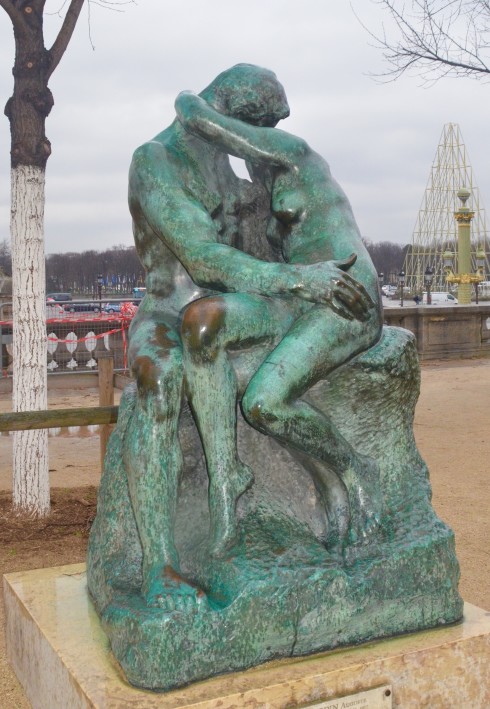
Time to go inside.
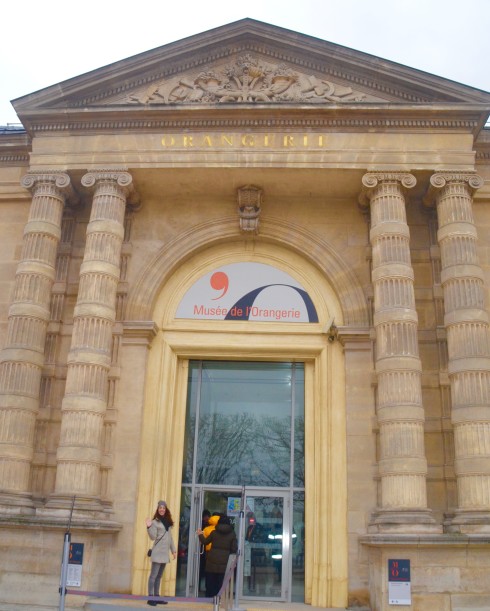
The admission fee is 12.50€ and another four for the audioguide. The latter is well worth it because almost every painting has an audioguide number on it and each contains a detailed description of what the painting is meant to represent and what was going on in the artist’s life at the time. I suspect this will be very useful when we get to the Cubists. Lenore and I agree to see the Walter and Guillaume collections first, each at our own pace and then go see the Monet’s together.
The first thing I notice is something that’s not here – hordes of tourists. In this place you can actually enjoy the art in relative peace. Here’s the Renoir gallery. You can also take non-flash photography and I didn’t see anyone breaking that rule, unlike the bigger places where it happens all the time. Sometimes I think they should keep industrial shredders in places that don’t allow flash photography. When the usual offenders ignore the rule, the security guards should just grab the camera/smart phone and dump it in the shredder.
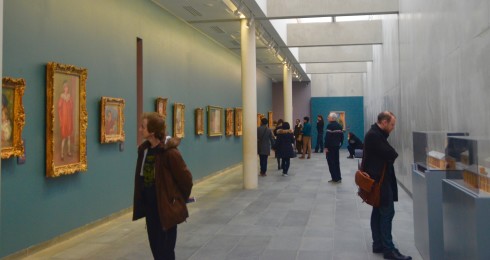
Orangerie Paintings
OK let’s start looking. The Orangerie website is absolutely top notch and has detailed descriptions of each painting. I will provide the link to the ones I include in this post.
The first painting I note is this portrait of the art dealer Paul Guillaume’s wife Domenica by Andre Derain. She was married first to Guillaume and then Jean Walter and was a driving force in getting the collections donated and on display here. But, according to the website description she was also a conniving bitch, nicknamed ‘diobolica’. There are 27 other Derain’s in the collection, but I liked this one best.
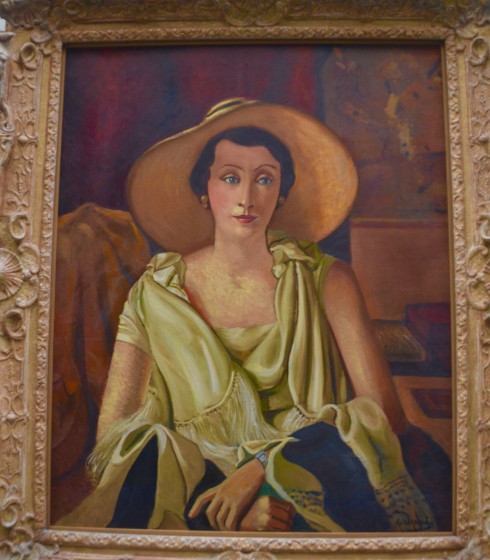
Renoir
There are no less than 24 works by Renoir of which many are considered top notch examples of this prolific artist’s best work, particularly the interior domestic scenes. I absolutely love this portrait of his son Jean and au pair Gabrielle. Jean Renoir went on to become famous in his own right as a film director of such timeless classics as La Grande Illusion and The Rules of the Game.
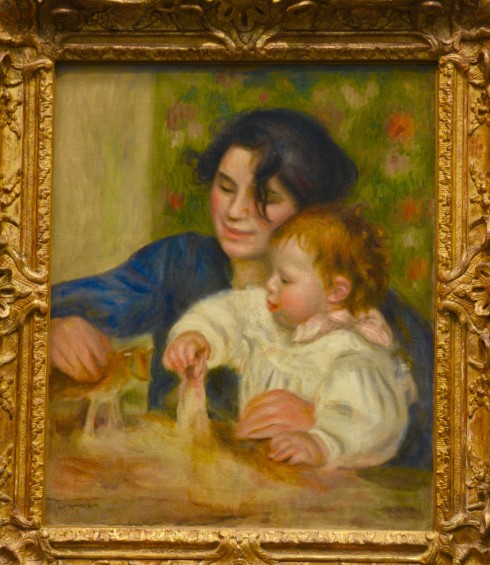
This next Renoir, illustrates how differently the lives of artists are from ordinary people. It’s Gabrielle again, but this time she is a reclining nude. Imagine trying to get away with having your baby sitter take off her clothes and sit for a portrait if you were just an ordinary Joe.
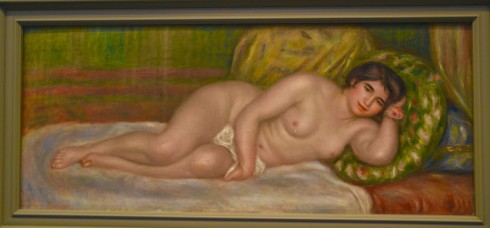
If the painting seems familiar, it should. Everyone from Titian to Manet painted reclining nudes. My two favourites are Goya’s Naked Maja
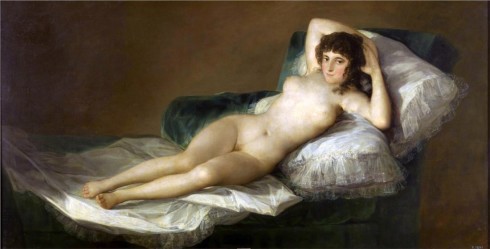
and Ingres’ La Grande Odalisque, which I could have seen if I went to the Louvre.
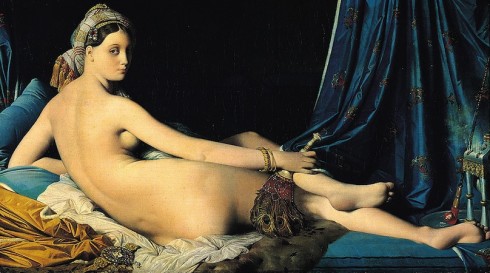
Both paintings are uncompromisingly sensual, while Renoir’s is just sweet innocence, almost like Gauguin’s Polynesian nudes.
Don’t think Renoir couldn’t do sexy if he wanted. Here he accomplishes it very well in Blond Girl with a Rose and the model still has her clothes on.
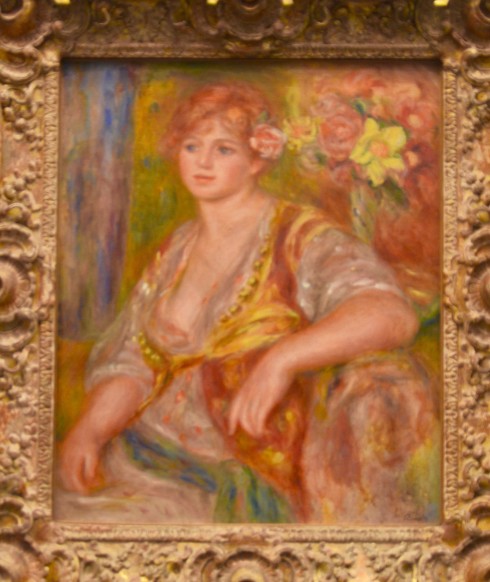
Back to the joys of childhood. This is young Claude Renoir Playing, looking very much like a little girl, but with a look of such intense concentration that only little boys seem to get out of toy soldiers.
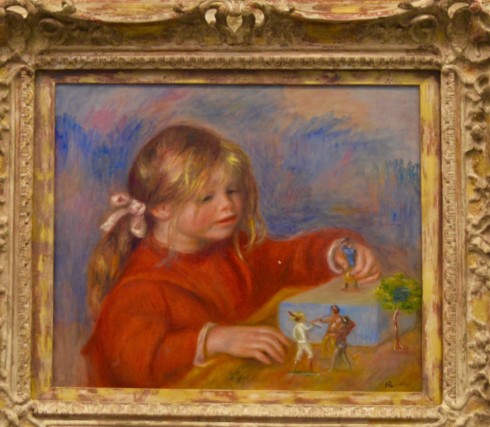
And here’s a Portrait of Two Little Girls. Just what is the smaller one whispering into the ear of the larger girl?
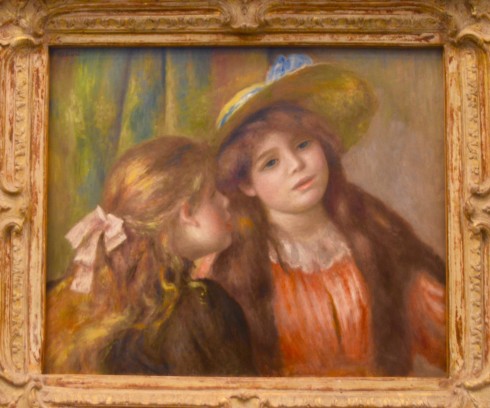
Maybe it’s the same two girls, now grown up, in Yvonne and Christine Lerolle at the Piano. The Lerolle family were friends of the artist Edgar Degas and Renoir has included two Degas’ paintings in the background of this one.
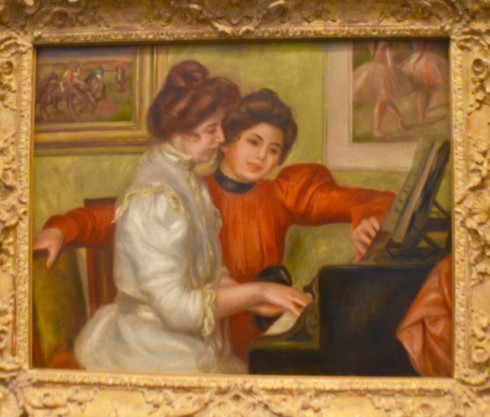
One last Renoir. Snow Covered Landscape is a jarring change from the quiet domestic interiors which make up most of the collection. It is done in the most typical Impressionist style and demonstrates that the artist could easily paint in a manner of ways that talented amateurs can only dream of.
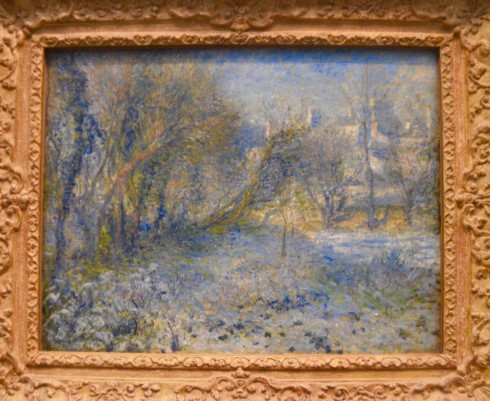
Cezanne
How about some Cezanne? Paul Cezanne was a post-Impressionist who developed a unique style that is unmistakeable. When I first started studying art it took me a while to warm up to his works. The muted colours and kind of blah scenes certainly don’t jump out and grab you, but after a while I came to realize the subtlety of Cezanne’s artistry and now understand why he is considered to be so great. Here are four very typical, and I’m not using that word pejoratively, Cezanne’s.
Pine Tree at L’Estaque is very simple and very powerful.
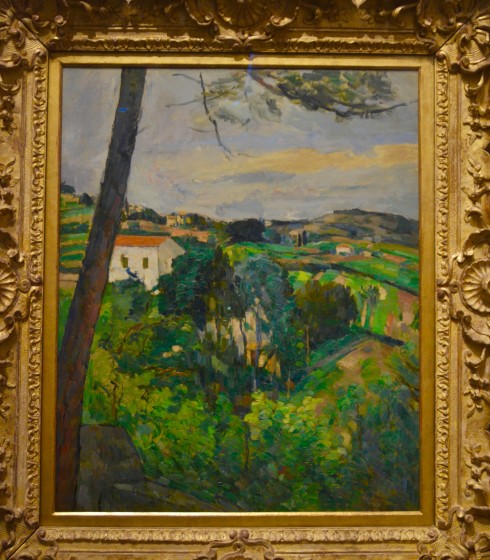
Trees and Houses has a mishmash of vertical and horizontal lines that somehow holds together. You can see why Cezanne influenced the Cubists and Fauvists, who came after him.
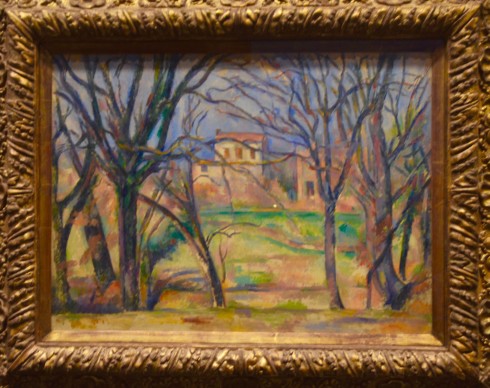
Of all the great artists of this period none paid the attention or had the skill to create remarkable still life more than did Cezanne. In Pear and Green Apples he creates something out of virtually nothing.
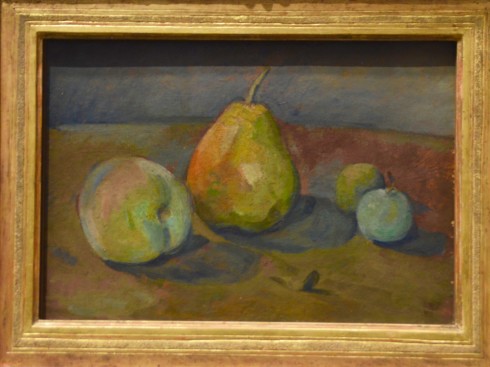
In Fruit, Napkin and Jug of Milk, Cezanne is at the top of his still life game. I stood and looked at this piece for a long time. If I was a photographer I’d never use this composition, but in this painting it really works. Cezanne seems to be communicating – “Yes, life’s really that simple.”
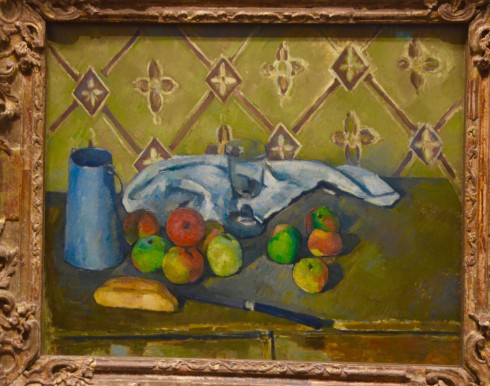
You can view these four and eleven more Cezannes at the Orangerie.
Matisse
Henri Matisse was another artist it took me time to warm up to and to paraphrase Longfellow’s “There was a little girl” when Matisse was good, he was very, very good and when he was bad he was horrid. Luckily for me the Orangerie has some of the very good Matisse’s including The Divan or Women and Sofa. It’s one of those paintings that looks far better in person than in a picture, including my own. The mix of colours is extraordinary. There’s something about the doors being ajar that you can debate in your head while you look at it. Is it menacing or is it liberating. Do you want to let the outside world in or keep it out? I have no clue what the answer is, or even if there was one in Matisse’s mind.
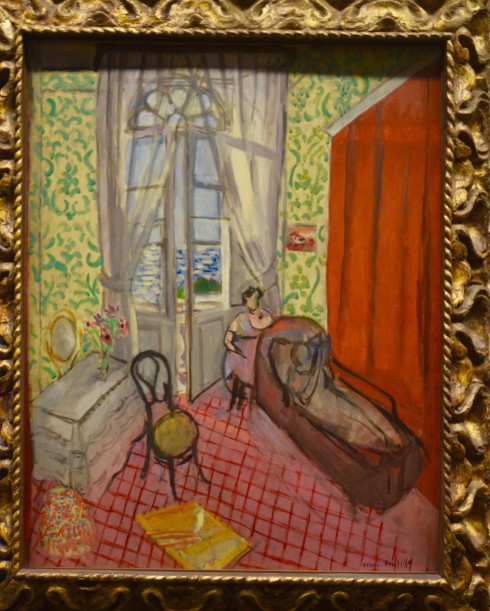
And here’s another really good one by Matisse – The Three Sisters is just brilliant. In composition, colour and expression everything about this painting works.
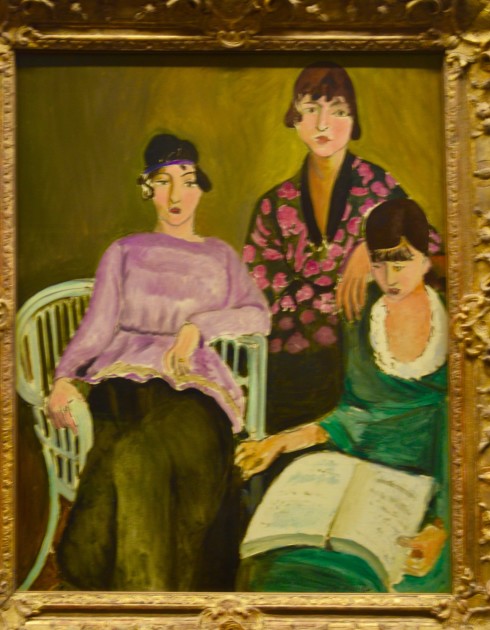
Besides these two there are eight more Matisse’s on display at the Orangerie and none of them fall into his horrid phase.
Picasso
We now come to perhaps the most controversial artists of the 20th century; Pablo Picasso was one hell of an artist and one horrible shit of a person. He was also as close to a human chameleon as an artist could be, going through complete changes of style and substance many times over his long career. The Orangerie has ten Picasso’s representing several of his distinct ‘periods’. In my opinion, The Embrace, from the blue period, is by far the most powerful and one of the best paintings in the entire museum. The combination of love and sorrow makes you wonder what the world will be like for the baby that the woman is bringing into it.
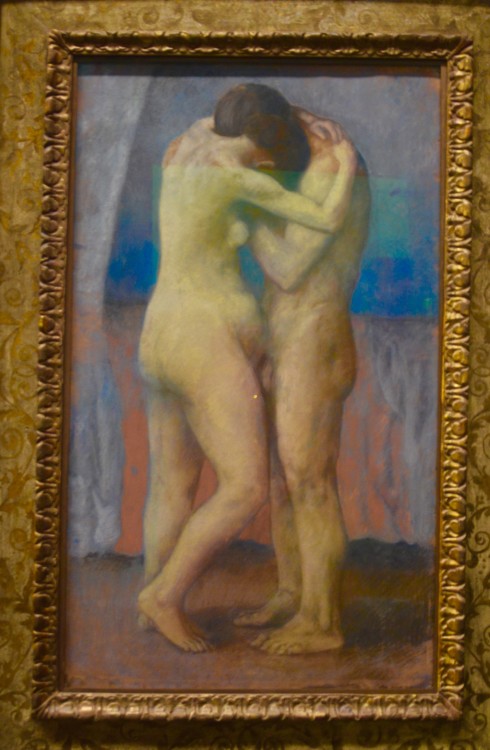
This next one I include only because it’s so creepy and contrasts so sharply with the Goya and Ingres nudes and even the Renoir. Before trans-gender was ever a topic on anyone’s mind Picasso painted Large Bather and it’s large in every way. I found this painting frankly a bit scary. Not because this might be a trans-gendered person, but because of the expression in the eyes.
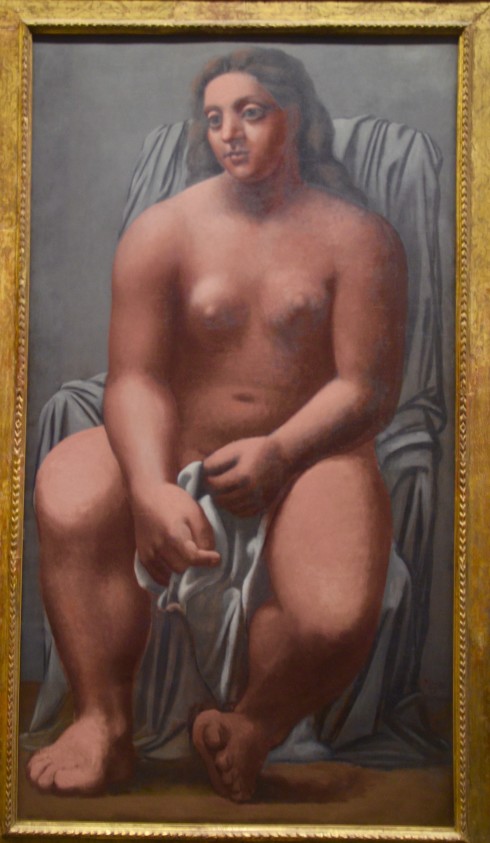
I mentioned earlier that some paintings come through much better on seeing them in person than any illustration or photograph can bring out. Strangely. the opposite can also be the case. This next Picasso is from his Cubist period and just doesn’t have the vibrancy or oomph that a lot of Cubist paintings can demonstrate. Large Still Life just seemed too dark and almost faded for my tastes. Last year I saw a collection of the great Spanish Cubist Juan Gris on display in Granada and his works were bright, complex and ultimately pleasing to the eye. Sorry Pablo you lose in the Cubist category.
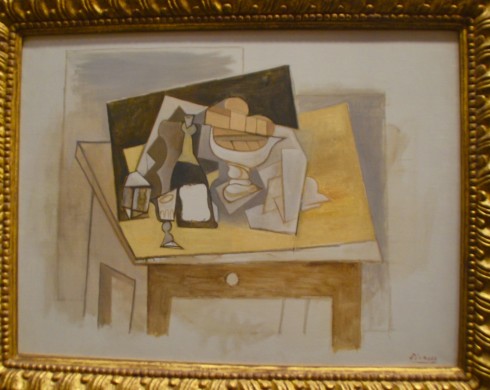
This last Picasso I’ll show you holds up much better from his Cubist period. Woman with Tambourine is from the last period that Picasso experimented with Cubism and this time I think he got it right. I know there are a lot of modern art detractors who would say that this looks like something a grade six student would paint, but I think not. That languid disinterested stare is not child’s play.
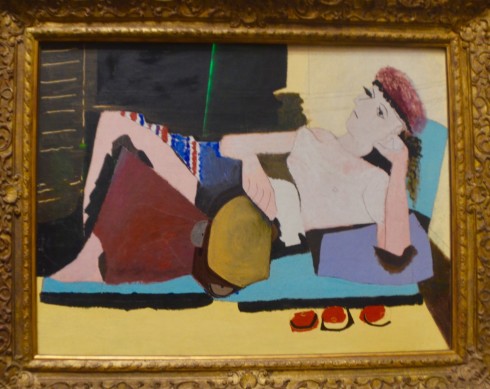
Modigliani
You couldn’t get a bigger contrast in artists than between Picasso and Amadeo Modigliani. Whereas Picasso was always trying to re-invent himself, once Modigliani matured as an artist he stuck with a style that produced some staggeringly powerful portraits. He died at 44, so maybe if he had lived he would have evolved, but in my opinion he simply could not improve, nobody could, on his unique style. There are five Modigliani’s in the Orangerie and The Young Apprentice could be called Modigliani does Cezanne. He does, and maybe better than Cezanne.
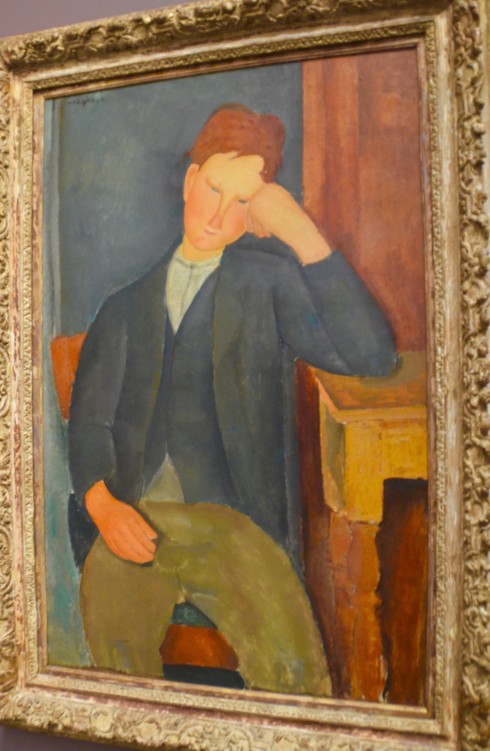
Henri Rousseau
The last artist I’m going to feature from the Guillaume/Walter collections is one so different from all the others that it seems strange that he’s here at all. Henri Rousseau was the first great practitioner of Naive Art and unparalleled by any who followed him. He took colour and simplicity of composition to new levels and carved a trajectory so different from his contemporaries that he was considered a simpleton by critics. However, he painted in this style because he wanted to and not because that’s the best he could do. Looking at a complete catalogue of his work reveals the ability to paint in the impressionist style or very good free hand. Now he is recognized as being a genius and is one of my favourite artists. For some reason the website does not have links to his works. Here is The Wedding.
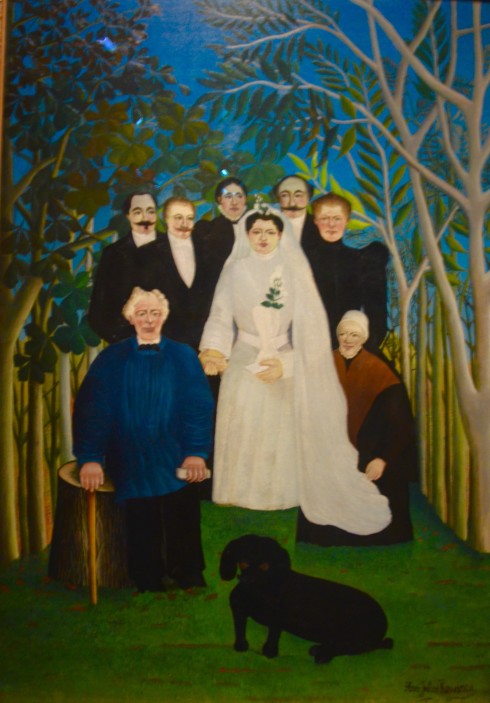
And Junier’s Cart. I love them both.
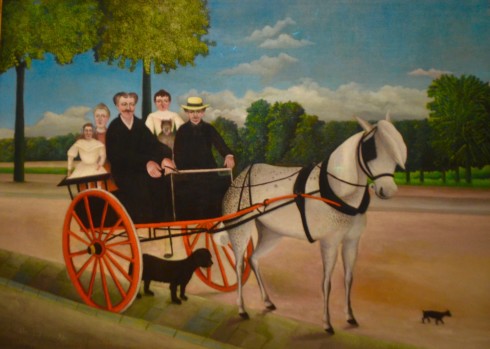
These are just some of the artists represented in the Guillaume/Walter collections. Next time I’ll come back and concentrate on Derain, Soutine, Sisley, Utrillo, Laurencin and Van Dongen. Time now to see the waterlilies.
Monet’s Waterlilies at The Orangerie
The eight massive waterlily paintings by Monet are displayed in two oval-shaped galleries on the top floor of the Orangerie, four to a room. The concave shapes of the walls creates a wrap around effect so that you can feel as if you are almost immersed in the pond where the lilies grow. Each reflects essentially the same scene from a different season, hour or vantage point. If you like your impressionist paintings big, then you’ve come to the right place. They are pretty well impossible to photograph with anything other than specialty equipment, but I’ll do my best. Also I’ll provide links to better photos.
Let’s start off with Sunset which is the first one you see. They are darker than I would have expected.
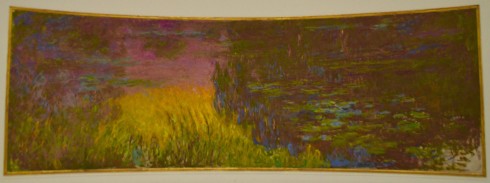
Next comes Clouds which are reflected in the water.
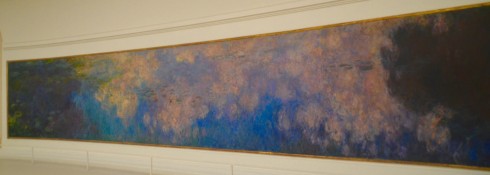
Opposite the Clouds is Morning.
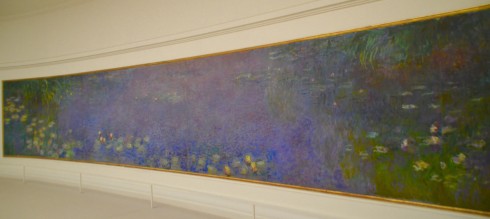
The second room features willow trees and branches in each painting. Here is Clear Morning with Willows.
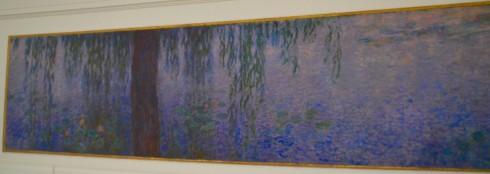
And finally, here’s Lenore in front of one of these massive canvases.
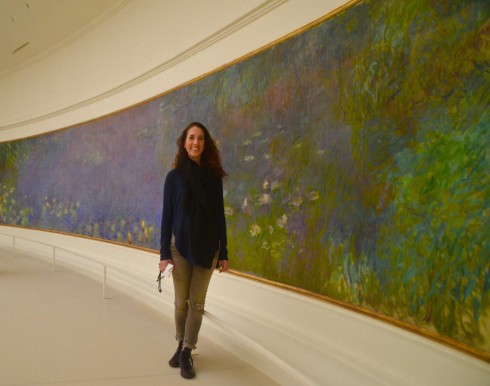
That concludes our trip to the Orangerie. I hope I have inspired you to visit on your next trip to Paris.
Other places I’ve visited on this trip to Paris and wrote posts you’ll find on this website include Versailles, the Pantheon, walking the Latin Quarter and the Cluny Museum.

